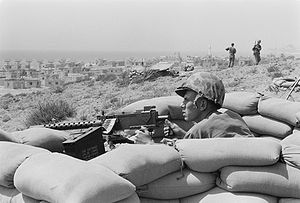1958 Lebanon crisis
| 1958 Lebanon Crisis | |||||||
|---|---|---|---|---|---|---|---|
| Part of the Arab Cold War | |||||||
 U.S. Marine sits in a foxhole outside Beirut, 1958 |
|||||||
|
|||||||
| Belligerents | |||||||
|
|
|||||||
| Commanders and leaders | |||||||
|
|
|
||||||
| Casualties and losses | |||||||
| 1,300–2,000 dead | |||||||
American-led government victory
The 1958 Lebanon crisis was a Lebanese political crisis caused by political and religious tensions in the country that included a U.S. military intervention. The intervention lasted around three months until President Camille Chamoun, who had requested the assistance, completed his term as president of Lebanon. American and Lebanese government forces successfully occupied the port and international airport of Beirut. With the crisis over, the United States withdrew.
In July 1958, Lebanon was threatened by a civil war between Maronite Christians and Muslims. Tensions with Egypt had escalated earlier in 1956 when pro-western Christian President Camille Chamoun did not break diplomatic relations with the Western powers that attacked Egypt during the Suez Crisis, angering Egyptian President Gamal Abdel Nasser. These tensions were further increased when Chamoun showed closeness to the Baghdad Pact. Nasser felt that the pro-western Baghdad Pact posed a threat to Arab nationalism. As a response, Egypt and Syria united into the United Arab Republic (UAR). Lebanese Sunni Prime Minister Rashid Karami supported Nasser in 1956 and 1958. Karami formed a national reconciliation government after the 1958 crisis ended.
...
Wikipedia
